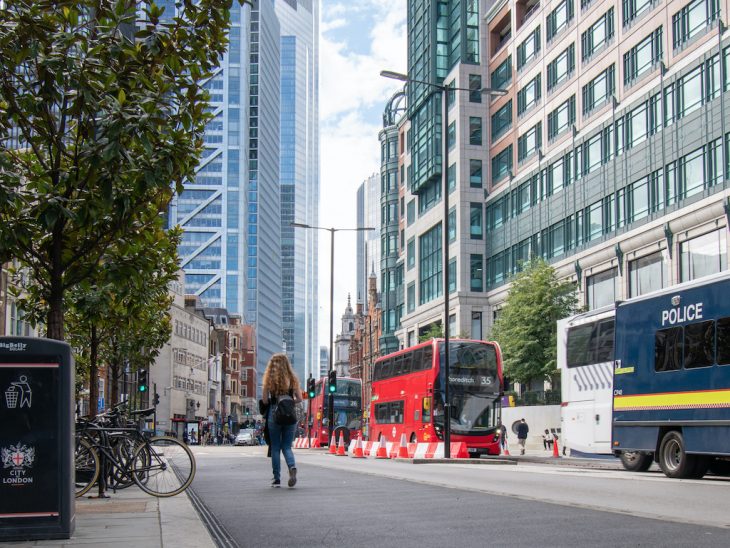Transport for London (TfL) has started work to transform one of central London’s major thoroughfares to support people walking, cycling and using the bus, as it warns that recovery from coronavirus must not be car-led.
As London’s safe public transport capacity continues to be restricted while social distancing measures remain, millions of journeys a day will need to be made by other means.
TfL is warning that if people switch these journeys to cars, London risks grinding to a halt, air quality will worsen, and road danger will increase. Congestion already costs London’s economy around £5bn per year, with drivers losing 227 hours per year to congestion.
Its work in the Bishopsgate central London corridor between Shoreditch and London Bridge will make cycling safer and easier, and wider pavements will make more space for people walking.
The work includes new traffic restrictions between Shoreditch and London Bridge; a key part of the Mayor of London and TfL’s Streetspace plans. The restrictions will be in operation on weekdays between 07:00 and 19:00, making it safer and easier for people to access central London by bike. Wider footways have been constructed along the corridor to give people on foot more space and a number of banned turns, which will be in operation 24 hours a day, will also be introduced along the road.
However, while the new measures will reduce the level of motor traffic on the road, TfL added that it’s committed to ensuring that Streetspace schemes are inclusive for all, which is why general traffic – including taxis – can continue to access the corridor from side streets during restricted hours.
The changes come as school children start to return and more people return to their workplaces and visit cultural and leisure destinations in central London.
The latest changes mark a significant step forward for TfL’s Streetspace programme, which since May has led to more than 50km of new or upgraded cycle infrastructure being built or currently under construction, along with more than 16,500 square metres of extra pavement space on the TfL network. TfL has also installed a total of 1,540 extra cycle parking spaces across London, focused around busy areas like high streets and transport hubs.
Mayor of London Sadiq Khan said: “With increasing numbers of people returning to central London, it’s more important than ever that we do all we can to avoid a damaging car-based recovery which would damage Londoners’ health and the economy. By creating more space to walk and cycle, our world-leading Streetspace for London plans are helping support a sustainable recovery for our city.”
And in recent weeks, TfL has joined with the walking and cycling charity Sustrans to introduce the Space to Move Map, which highlights the changes being made across London. The map makes it possible for Londoners to see where TfL and London boroughs are making it easier to walk and cycle safely and provides an opportunity for feedback. Using the map, people can search their area for new walking and cycling infrastructure and share their views with TfL directly.
TfL is also planning work on further low-traffic corridors in central London, including between Old Street and Holborn, with further details to be set out in the autumn.











































